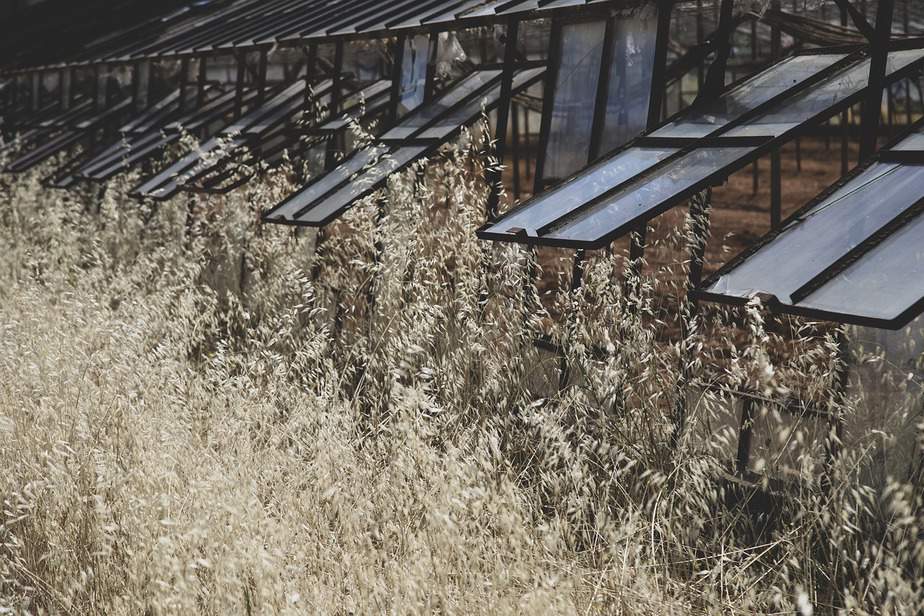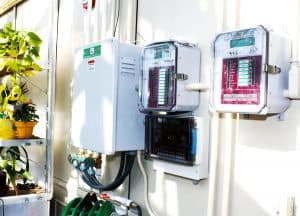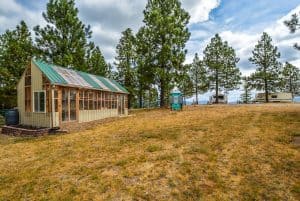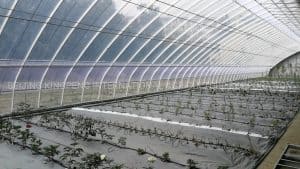Greenhouses have become increasingly necessary in the agricultural industry due to high global populations with increased demand for their favorite food year round. They’re also pretty popular for households that want to try their hand at homegrown vegetables and flowers.

Like anything else, greenhouses come with several benefits and some disadvantages. What’re the pros and cons of greenhouses? Well, we’ll discuss them here.
The Pros and Cons of Greenhouses
As with anything worth doing, there are pros and cons associated. When it comes to greenhouses, the pros and cons can be a green light or red flag depending on your personal situation. So, let’s discuss the good and bad of greenhouses.
Defining the Greenhouse
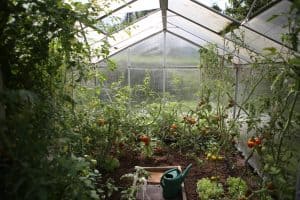
Just so we’re all on the same page, let’s establish what exactly a greenhouse is.
A greenhouse is a structure made out of transparent material, usually glass and sometimes plastic, to grow plants or crops in a controlled/regulated environment. Greenhouses can range in size from a small shed with a single gardener to high-tech, industrial-sized buildings with over a hundred employees. Sometimes referred to as glasshouses or hothouses, greenhouses use an enclosed structure to reduce heat loss and preserve a heated environment to extend the plant-growing season.
Need another take on greenhouses before you definitively decide? This ultimate greenhouse guide will give you all the information you’re craving and more!
For now, let’s get to the pros and cons of greenhouses. If you feel we’ve missed something, then bring in up in the comments section so that we can address it.
Advantages of Greenhouses
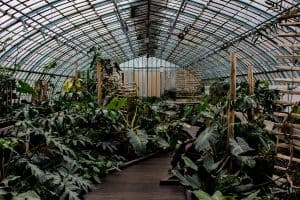
Do note that depending on the type of greenhouse you’re considering, the pros and cons associated will be minutely different. If you have any questions or concerns then feel free to raise them in the comments – we’d love to help find an answer!
1. Increased production and yield
The most obvious reason for opting a greenhouse in farming is to extend the growing season by controlling the climate within the structure. Typically, greenhouses are kept hotter than the temperature of the surroundings to prevent the plant growth from retarding in the colder seasons. This allows production and growth to continue even when the current season or climate would not allow it.
2. Year-round growth
For some species, regular growth can be continued for the whole year by maintaining a desirable climate so that crops and ornamental species that would not customarily grow in the colder regions can be grown as well. Similarly, it is just as possible to keep a controlled, cool environment to grow some plant species in warmer or tropical regions that would not otherwise be possible. Not adhering to the constraints of regional temperatures and climates means a greater variety of crops and plants to be grown.
3. Minimal production risks
Having a greenhouse as an enclosed space to grow and maintain your crops can protect them from the threat of damage by pests. This means that no need exists for applying environmentally unsafe chemical pesticides to the plants and crops, which can end up polluting water supplies with their high levels of nitrogen and phosphorus contributing to eutrophication.
In the same vein, a protected, closed growing area keeps growing plants safe from disruption from animals. There is no threat of rabbits, raccoons, stray cats or other animals running across the plant fields and damaging them.
4. Maximization of profits
Greenhouses also allow for a lot of monetary savings by increasing yields of produce due to the extended growth periods. The longer the growth period, the more plants will be expected to be grown, which can save locals from buying high-priced fruits and vegetables from groceries.
For farmers, it allows them to have an edge over the competition. They can also keep prices high and get higher profits in the offseason due to a low supply in terms of demand. Greenhouses can act as an intensive agriculture system and can provide crop farmers with a good overall output.
In farming, people tend to start seeds indoors, tend to their health, and once they have stabilized, shift them outdoors for the rest of the plant growth. With a greenhouse, starting seeds can become a much easier process and the mess of mud, pots, and soil can be avoided that would have been the case if you start seeds inside the house or garage.
5. Protection from changing weather conditions
Having a greenhouse can minimize risks associated with climate change. Due to increasingly undeterminable seasonal events including sudden low temperatures or flash storms, a lot of growing crops can get damaged or die out. Extreme rain and storm events or unexpected dry spells can come in the way of a plant’s health. A greenhouse can protect the plants and vital crops from all of that by maintaining optimum growing conditions.
6. Aesthetic appeal
Household greenhouses have a positive aesthetic element attached to them. A glasshouse full of greenery can elevate the look of your house and backyard. It can even become a safe, quiet haven for the owner to sit and relax in. It has been known that leaves and green spaces can positively affect a person’s mood and general health. Especially on a cold, winter day, a warm, cozy space like a greenhouse can be a great spot to relax in.
Greenhouses can allow for a great many advantages and can create for a good investment of time and energy to set up. However, before anyone gets too comfortable with the idea, it is helpful to consider some of the pitfalls of owning and managing a greenhouse.
Disadvantages of Greenhouses
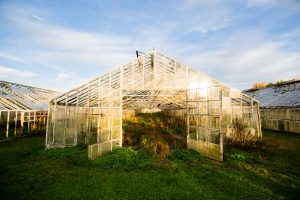
1. Sizeable Initial Investment
To start with, greenhouses come with a hefty balance sheet. Just the expenses for a household setup alone could range in the hundreds or thousands of dollars. That is a big ask. A commercial grade greenhouse is an even bigger undertaking in terms of funds. The prices could come anywhere in the tens to hundreds of thousands. Careful consideration is required, and funds need to be properly allocated before a project like this is undertaken.
2. High Operating Cost
A good functioning greenhouse requires for a specific temperature to be maintained, controllable and monitored air circulation and, in more high-tech cases, pressure and humidity sensors. As such, fans, heaters, thermostats and other gardening or farming supplies are required. Most of these require electricity to run. Counting all that adds up to big initial investment and operating cost that could take a significant amount of time just to break even, let alone earn the owner profits.
3. The Requirement of a Precise Design
It must also be added to the consideration that greenhouses are not easy to construct. A simple glass box structure may seem like it is reasonable enough to be a greenhouse but that is generally not the case. A proper functioning greenhouse will need to be designed and engineered based on a wide range of factors with detailed and precise calculations.
Decisions made are based on the available and most constructive location, the type of crops available to be grown, the optimum direction to refract the highest fraction of solar irradiation and the required technology that will accompany the setup. All of these require a lot of research and thought. A consultation with a professional may also be needed before anything can be started. If a haphazard decision is taken, the effectiveness of the whole system may be compromised.
4. Requires skilled management
Greenhouses also tend to be energy intensive systems. While many smaller greenhouses manage the internal environment by just utilizing the laws of physics through the trapping of solar radiation and the manipulation of indoor air currents, fully, or even moderately, commercialized systems tend to require grid-powered electric fans and heaters, and also temperature, pressure and humidity sensors to manage the system. Unless the greenhouse is solar powered, this type of system fails to be environmentally sustainable for just this reason.
5. Water requirement
Greenhouses are also known to be net water users as the closed system does not receive any water from the rain, so water from the supply is used to cater to the plants’ needs. This, again, brings the system’s sustainability to be questioned unless it is catered to by utilizing a rainwater harvesting system to provide the water required, thus conserving the resource (hint – it’s doable via the instruction in the links!).
6. Optimal infection/disease growth conditions
Although the enclosed environment of the greenhouse can protect the plants and crops from threats of the outdoors like stray animals and birds, this contained space comes with its own problems. As air is often recirculated inside the greenhouse, if a plant develops a fungus or a disease, the chance of other grown crops or plants are much more likely to find themselves catching it too.
This can be quite problematic as the more plants get infected, the more chances there are for others to get affected too. The ensuing damage could cause the owner a pretty penny in repairs, ointments, and replacements to say nothing of the fully-grown crops and flowers. If not properly dealt with, in the initial stages, the disease could quickly grow to damage and retard the growth of all the other plants in the greenhouse.
7. The Requirement of a Skilled Gardener
Outdoor, healthy plants growth and plant diversity depend on one vital factor: bees. Bees are nature’s pollinators and, with the assistance of strong winds, are extensively effective in fulfilling the pollination requirements of many plants. In a greenhouse, however, the presence of bees is non-existent, and no strong winds are allowed to permeate inside.
Pollination is to be catered for by the gardener themselves. This is a menial task to be performed manually. The gardener will have to shake or tap the flowers individually with a cotton swab or paintbrush to extract the pollen from the flower and transfer it to the next. In commercial structures, workers will have to be specifically trained to manage an effective pollination system.
8. High Maintenance
Greenhouses are made to maintain the desired temperature conditions. This is far easier said than done. Complete reliance cannot be placed on the sun’s radiation and its heat. If such is the case, then the greenhouse will build temperature up quite quickly, but this high temperature will not maintain itself. Temperatures inside most definitely fluctuate, decreasing the overall efficiency of the system.
Catering to fluctuations in the environment of the greenhouse can be tricky and a job that requires constant vigilance. Plants will also have to be checked for their hydration levels and general health. Additionally, the soil’s moisture and strength are also affected by temperature and so must also be kept in the notice. Care should be taken to prevent the soil from drying up due to intense heat. All of this management makes greenhouse maintenance and operation a time-consuming and strenuous task.
Catering to all the factors that are involved in the operations at a greenhouse takes a lot of effort and skill. In commercial greenhouse farming, skilled labor with training is required to maintain optimum growing conditions. In case of any issue, these workers must be capable enough to root out the problem, fix it and make sure that the plants are not disturbed during all of it. Labour with this caliber of technical training can be expensive, adding to the already high costs of the greenhouse.
That Dream Look Comes with Hard Work
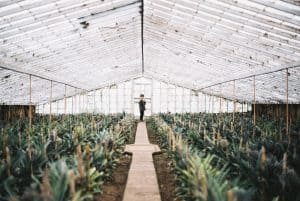
The aesthetic is a purely subjective concept. While there are many that would agree that a greenhouse enhances the aesthetic of a homeowner’s yard, there are those who find it to be an obstruction of the view and argue that a big structure like that takes away from the beauty of the property. The pros and cons of greenhouses truly are subject to individual scrutiny more than most things.
Some greenhouses may seem imposing and may stand out too much, essentially distracting the onlooker from anything else in the space. Another concern is that keeping a greenhouse looking aesthetically pleasing requires significant upkeep. The glass walls get stained very quickly, most commonly by water droplets and wet mud, and the transparency of the structure allows for any mess that has been made inside to be visible to an onlooker outside as well.
Tacking on to the last point, the upkeep of a greenhouse takes up a lot of time and effort. This task is made harder by how big the structure is. Loose soil is known to line the floor and much of it gets on the walls as well. Clearing it up completely can be nearly impossible. Water vapors present in the humid air are also known to condense onto the glass walls and droplet marks. These stains are a constant eyesore and require regular washing of the glass which can definitely not be a one-person job.
For businessmen partaking in greenhouse farming, it is imperative to note that they should have a distribution network planned and catered for before the crops are grown. The greatest benefit of greenhouses is that they allow farmers to grow and sell their produce in the offseason. They can very well lose this edge to competitors if any delay is made in transportation and the crops become overripe. This selling and distribution network will require connections and partnerships that are hard to come by.
So, how do the pros and cons of greenhouses weigh out? Well, it’s totally dependent on your situation, but if you’re gung-ho about greenhouses, then go ahead and get going!

